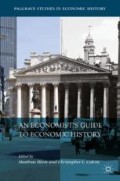Abstract
Since financial bubbles and crises are rare events, modern empirical evidence on these phenomena is very limited. Economic history has therefore been fundamental to the development of this field. Histories of financial crises traditionally address questions about individual incidents. Enquiry into the Great Depression has proved especially popular. This chapter explains how the traditional approach is now complemented by studies applying econometric techniques to long-run data.
Access this chapter
Tax calculation will be finalised at checkout
Purchases are for personal use only
Reading List
Bernanke, B.S. 1983. Nonmonetary Effects of the Financial Crisis in the Propagation of the Great Depression. American Economic Review 73 (3): 257–276.
Campbell, G. 2012. Myopic Rationality in a Mania. Explorations in Economic History 49 (1): 75–91.
———. 2013. Deriving the Railway Mania. Financial History Review 20 (1): 1–27.
Campbell, G., and J.D. Turner. 2012. Dispelling the Myth of the Naive Investor during the British Railway Mania, 1845–1846. Business History Review 86 (1): 3–41.
Cecchetti, S.G. 1992. Prices during the Great Depression: Was the Deflation of 1930–1932 Really Unanticipated? American Economic Review 82 (1): 141–156.
Crafts, N., and P. Fearon. 2010. Lessons from the 1930s Great Depression. Oxford Review of Economic Policy 26 (3): 285–317.
Dickson, P.G.M. 1967. The Financial Revolution in England: A Study in the Development of Public Credit, 1688–1756. London: Macmillan.
Dowd, K. 1996. The Case for Financial Laissez-Faire. The Economic Journal 106 (436): 679–687.
Eichengreen, B., and Mitchener, K.J. 2003. The Great Depression as a Credit Boom Gone Wrong. BIS Working Paper Series, Paper No. 137.
Eichengreen, B., and P. Temin. 2000. The Gold Standard and the Great Depression. Contemporary European History 9 (2): 183–207.
Fama, E.F. 1990. Stock Returns, Expected Returns, and Real Activity. The Journal of Finance 45 (4): 1089–1108.
Friedman, M., and A.J. Schwartz. 1963. A Monetary History of the United States, 1867–1960. Princeton, NJ: Princeton University Press.
Galbraith, J.K. 1955. The Great Crash 1929. London: Hamish Hamilton.
Garber, P.M. 1990. Famous First Bubbles. Journal of Economic Perspectives 4 (2): 35–54.
Goetzmann, W.N. 2015. Bubble Investing: Learning from History. NBER Working Paper Series, Paper No. w21693.
Hamilton, J.D. 1987. Monetary Factors in the Great Depression. Journal of Monetary Economics 19 (2): 145–169.
Hickson, C.R., and J.D. Turner. 2002. Free Banking Gone Awry: The Australian Banking Crisis of 1893. Financial History Review 9 (2): 147–167.
Jordà, Ò., M. Schularick, and A.M. Taylor. 2013. When Credit Bites Back. Journal of Money, Credit and Banking 45 (2): 3–28.
Kindleberger, C.P. 1978. Manias, Panics, and Crashes: A History of Financial Crises. 1st ed. London: Macmillan.
Mackay, C. 1852. Memoirs of Extraordinary Popular Delusions and the Madness of Crowds. 2nd ed. London: Robson, Levey and Franklin.
Money: A Journal of Business and Finance. 1896. A History of Panics, 759–760.
Neal, L. 1990. The Rise of Financial Capitalism: International Capital Markets in the Age of Reason. Cambridge: Cambridge University Press.
O’Hara, M. 2008. Bubbles: Some Perspectives (and Loose Talk) from History. The Review of Financial Studies 21 (1): 11–17.
Pástor, L., and P. Veronesi. 2009. Technological Revolutions and Stock Prices. American Economic Review 99: 1451–1483.
Perez, C. 2002. Technological Revolutions and Financial Capital: The Dynamics of Bubbles and Golden Ages. Cheltenham: Edward Elgar.
Quinn, W. 2018. Technological Revolutions and Speculative Finance: Evidence from the British Bicycle Mania. Cambridge Journal of Economics. https://doi.org/10.1093/cje/bey029.
Reinhart, C.M., and K.S. Rogoff. 2009. This Time is Different: Eight Centuries of Financial Folly. Princeton, NJ: Princeton University Press.
Romer, C.D. 1990. The Great Crash and the Onset of the Great Depression. The Quarterly Journal of Economics 105 (3): 597–624.
Romer, C.D., and D.H. Romer. 2013. The Missing Transmission Mechanism in the Monetary Explanation of the Great Depression. American Economic Review 103 (3): 66–72.
Schularick, M., and A.M. Taylor. 2012. Credit Booms Gone Bust: Monetary Policy, Leverage Cycles, and Financial Crises, 1870–2008. American Economic Review 102 (2): 1029–1061.
Shiller, R. 2015. Irrational Exuberance, 3rd Edition. Princeton, NJ: Princeton University Press.
Temin, P. 1975. Did Monetary Forces Cause the Great Depression? New York: W. W. Norton.
———. 1976. Lessons for the Present from the Great Depression. American Economic Review 66 (2): 40–45.
———. 2008. The German Crisis of 1931: Evidence and Tradition. Cliometrica 2 (1): 5–17.
Thompson, E.A. 2007. The Tulipmania: Fact or Artifact? Public Choice 130 (1–2): 99–114.
Turner, J.D. 2014. Banking in Crisis: The Rise and Fall of British Banking Stability, 1800 to the Present. Cambridge: Cambridge University Press.
Velde, F. 2009. Was John Law’s System a Bubble? The Mississippi Bubble Revisited. In The Origin and Development of Financial Markets and Institutions From the Seventeenth Century to the Present, ed. J. Atack and L. Neal. Cambridge: Cambridge University Press.
Voth, H.J. 2003. With a Bang, Not a Whimper: Pricking Germany’s ‘Stock Market Bubble’ in 1927 and the Slide into Depression. Journal of Economic History 63 (1): 65–99.
Author information
Authors and Affiliations
Editor information
Editors and Affiliations
Rights and permissions
Copyright information
© 2018 The Author(s)
About this chapter
Cite this chapter
Quinn, W. (2018). Financial Crises and Bubbles. In: Blum, M., Colvin, C. (eds) An Economist’s Guide to Economic History. Palgrave Studies in Economic History. Palgrave Macmillan, Cham. https://doi.org/10.1007/978-3-319-96568-0_12
Download citation
DOI: https://doi.org/10.1007/978-3-319-96568-0_12
Published:
Publisher Name: Palgrave Macmillan, Cham
Print ISBN: 978-3-319-96567-3
Online ISBN: 978-3-319-96568-0
eBook Packages: Economics and FinanceEconomics and Finance (R0)

